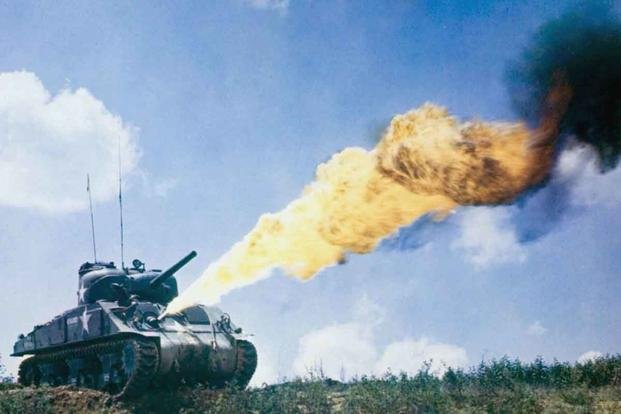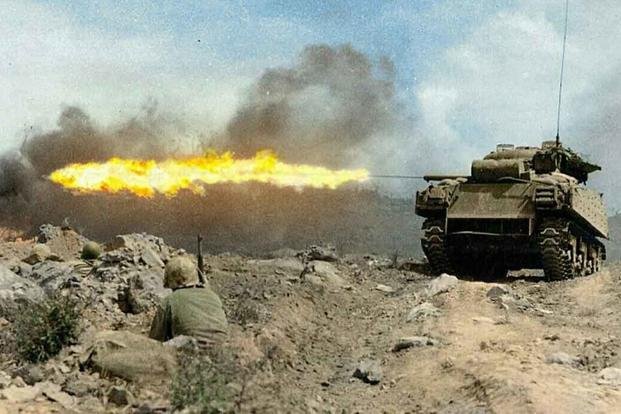Iwo Jima was a small but formidable target for the Allies in the Pacific Theater of World War II.
Japanese troops spent an entire year turning the island into a fortress. U.S. Marines would have to capture eight square miles of heavily fortified infantry and artillery positions, which included a network of pillboxes and bunkers above ground, along with 11 miles of reinforced concrete tunnels underground.
Those tunnels would make the island's defenses almost impervious to Allied bombing and naval barrages. On top of all that, the Japanese had machine-gun nests, mortars and armor to push any landing back into the sea.
But the Marines brought to bear a weapon that Japanese infantrymen actually feared: the modified Sherman M4A3 "Zippo" Tank, "the one weapon that caused the Japs to leave their caves and rock crevices and run," according to a 1st Marine Division history article.
The U.S. couldn't afford to hop over Iwo Jima, as it had many other Japanese-held islands. Aircraft on Iwo Jima could intercept bombers headed for the Japanese mainland and warn the home islands of incoming attacks. If American troops could capture the island, they could use it as a staging area for attacks on Japan and fly bombing missions with fighter escorts.
When Marines first landed on the beaches, they met light resistance and gathered forces for about an hour. That's when the Japanese opened up on them in what one war correspondent called "a nightmare in hell."
But the Marines brought their own nightmare to the fight. The M2 flamethrower used by Marine Corps infantry was a backpack-carried weapon effective in clearing out caves, pillboxes and other reinforced positions. It had proven itself to be an effective weapon in the fighting on Pacific Islands.
The problem was that the lifespan of a Marine wielding the flamethrower was roughly four minutes. Aside from the fact that they were carrying compressed gas and liquid fuel on their backs, the bright orange flames made them an attractive target for snipers. The close range required for its use made them extremely vulnerable to small-arms fire, and the cumbersome nature of the weapon forced them to move at a slower pace.
The solution was to mount the flamethrower on an armored vehicle.

After a few iterations of mounting flamethrowers onto light-armored vehicles in the Marianas and on Peleliu, U.S. Navy Seabees finally modified a Sherman M4A3 tank with the Mark-1 flamethrower. Marines now had an armored vehicle that fired napalm-thickened death through a 75mm main gun with a range of 150 yards.
The Navy landed all eight of its flamethrower tanks onto Iwo Jima on the first day, but they weren't used until the second day of fighting. Once their effectiveness was realized, however, word quickly spread, and Marines held off their advances until the flaming Sherman tanks could be brought to bear.
"Zippo" tanks -- as they came to be called -- were much more effective against the caves and reinforced concrete than aerial bombardment or naval artillery. The Japanese troops did everything they could, including suicidal attacks, to stop the Shermans from torching their defenses. But the tanks kept on, dousing the defenders with about 10,000 gallons of napalm every day of the battle.
Fighting on Iwo Jima raged on for 36 days, killing nearly 7,000 Americans. Japanese deaths numbered around 18,000.
Capt. Frank C. Caldwell, a company commander with the 26th Marines, said of the modified flamethrower tanks, "In my view, it was the flame tank more than any other supporting arm that won this battle."
-- Blake Stilwell can be reached at blake.stilwell@military.com. He can also be found on Twitter @blakestilwell or on Facebook.
Want to Learn More About Military Life?
Whether you're thinking of joining the military, looking for post-military careers or keeping up with military life and benefits, Military.com has you covered. Subscribe to Military.com to have military news, updates and resources delivered directly to your inbox.
















